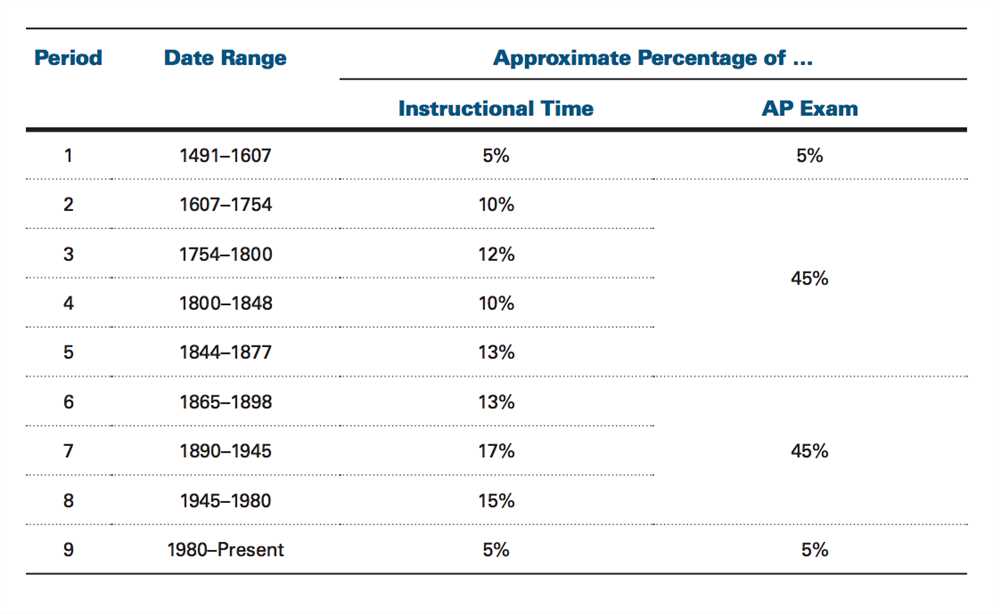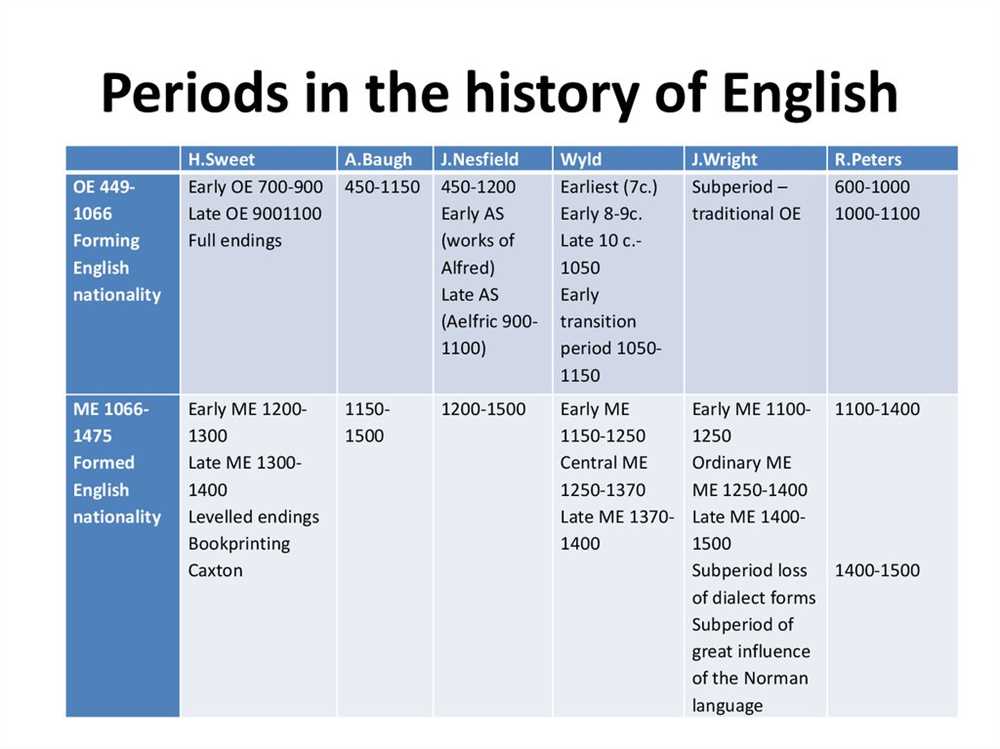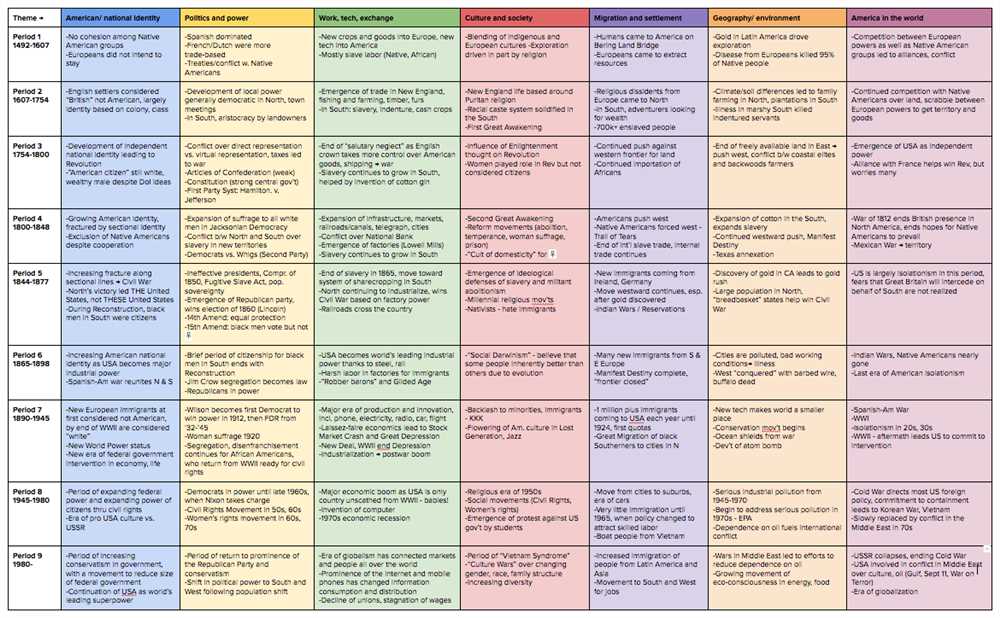
As an AP US History student, period 3 is a crucial time period to study. It covers the years 1754-1800 and is characterized by major events such as the American Revolution, the creation of the Constitution, and the early years of the new nation. To ensure success on the AP US History exam, it is essential to thoroughly understand the key concepts and events of this period.
This practice test is designed to help you assess your knowledge and readiness for the exam. It includes a variety of multiple-choice questions that cover important topics of period 3, such as the causes and consequences of the American Revolution, the impact of the Articles of Confederation, and the debates surrounding the creation of the Constitution. By taking this practice test, you will not only identify areas of strength but also areas that require further study and review.
By familiarizing yourself with the types of questions and content that may appear on the exam, you can gain confidence and strengthen your ability to apply your knowledge effectively. This practice test is an invaluable resource for self-assessment and exam preparation. Take the time to go through each question, analyze the answer choices, and choose the best response based on your understanding of the material. Remember to pace yourself and simulate test conditions to get a realistic sense of your abilities.
Don’t miss this opportunity to gauge your progress and reinforce your understanding of AP US History period 3. Use this practice test as a stepping stone towards achieving exam success and confidently demonstrating your knowledge of this pivotal period in American history. Good luck!
Key Terms and Concepts
In the study of AP US History, Period 3 covers the time period from 1754 to 1800. This period was marked by significant events that shaped the course of American history, including the French and Indian War, the American Revolution, and the formation of the new American government. Understanding the key terms and concepts from this period is crucial for a comprehensive understanding of the events that unfolded during this time.
French and Indian War: This war, fought between 1754 and 1763, was a conflict between the British and French over control of territory in North America. It was a pivotal event that set the stage for the American Revolution.
American Revolution: The American Revolution, which took place from 1765 to 1783, was a war fought by the American colonies to gain independence from Great Britain. This revolution resulted in the formation of the United States of America.
Declaration of Independence: The Declaration of Independence was a document adopted by the Second Continental Congress on July 4, 1776. It announced the thirteen American colonies’ decision to break away from British rule and established the principles of equality and individual rights.
Articles of Confederation: The Articles of Confederation were the first constitution of the United States, adopted in 1781. It created a weak central government with limited powers and ultimately proved ineffective, leading to the formation of the Constitution.
Constitutional Convention: The Constitutional Convention was held in Philadelphia in 1787 to address the problems with the Articles of Confederation. During this convention, the Constitution of the United States was drafted and established the framework for the new American government.
Bill of Rights: The Bill of Rights refers to the first ten amendments to the United States Constitution. These amendments were ratified in 1791 and protected individual liberties and rights.
Overview of Period 3
Period 3 of AP US History covers the time period between 1754 and 1800, which includes the events leading up to the American Revolution, the establishment of the United States as an independent nation, and the early years of the new republic. During this period, the American colonies underwent significant changes politically, socially, and economically, setting the stage for the formation of a new nation.
One of the key events during this period is the French and Indian War, which took place between 1754 and 1763. This conflict between the British and French, with Native American allies on both sides, resulted in the British gaining control over large territories in North America. However, it also led to increased tensions between the colonists and the British government, as the British attempted to impose new taxes and restrictions on the colonies to pay for the war.
Another important event during Period 3 is the American Revolution, which began in 1775 and lasted until 1783. This war was fought between the American colonies and Great Britain, and resulted in the colonies gaining their independence and establishing the United States of America. The Revolution was influenced by ideas of natural rights and liberty, as well as the experiences of self-government in the colonial period.
Colonial Resistance and Revolutionary War
During the period of colonial resistance to British rule, tensions between the American colonists and the British government steadily escalated. The colonists were not willing to accept the increasing control and taxation imposed by the British, which led to a series of protests and acts of resistance. These acts varied in their nature and intensity, ranging from non-importation agreements to riots and boycotts. The colonists were particularly angered by the Stamp Act of 1765, which required them to pay a tax on various legal documents and printed materials. This act sparked widespread opposition and played a significant role in uniting the colonists against British rule.
As the resistance grew, so did the call for independence from Britain. The American Revolution, which lasted from 1775 to 1783, was the culmination of this resistance and the struggle for freedom and self-governance. The revolution began with the battles of Lexington and Concord, where colonists fought against British troops in an effort to protect their rights and liberties. These battles marked the start of a long and grueling war for independence.
Throughout the Revolutionary War, the colonists faced numerous challenges. They lacked a professional military and struggled to maintain supply lines and recruit troops. However, they were able to rely on the leadership of figures such as George Washington and the aid of foreign powers like France, who provided crucial support to the colonists’ cause. The war was marked by significant victories, such as the Battle of Saratoga in 1777, which convinced France to formally ally with the American colonies. Finally, in 1783, the Treaty of Paris was signed, recognizing the United States as an independent nation and officially ending the war.
- The period of colonial resistance to British rule was marked by protests and acts of resistance by the American colonists.
- The Stamp Act of 1765 played a significant role in uniting the colonists against British rule and sparked widespread opposition.
- The American Revolution, which lasted from 1775 to 1783, was the culmination of the resistance and the struggle for independence.
- The colonists faced challenges during the Revolutionary War, but were able to rely on key leaders and support from foreign powers.
- The war ended with the signing of the Treaty of Paris in 1783, recognizing the United States as an independent nation.
Articles of Confederation and Constitutional Convention
The Articles of Confederation were the first written constitution of the United States, in effect from 1781 to 1789. They were created during the American Revolution as a way to unite the thirteen original colonies and establish a central government. However, the Articles of Confederation had several weaknesses that led to the need for a Constitutional Convention.
Under the Articles, the central government was extremely weak. There was no executive branch, which meant that there was no president to enforce laws or carry out the day-to-day operations of government. Additionally, the central government could not impose taxes or regulate commerce, making it difficult to fund the government or maintain economic stability. Furthermore, the Articles required unanimous consent from the states to make any changes, making it difficult to pass legislation or make amendments.
Recognizing the need for a stronger central government, the Constitutional Convention was held in Philadelphia in 1787. Delegates from twelve of the thirteen states (Rhode Island did not send delegates) gathered to draft a new constitution. Led by figures such as James Madison and Alexander Hamilton, the delegates worked to create a document that would address the weaknesses of the Articles of Confederation while still preserving the freedoms and rights of the states.
The result of the Constitutional Convention was the United States Constitution, which established a more powerful central government with separate branches – executive, legislative, and judicial – and a system of checks and balances. The Constitution also outlined the powers and responsibilities of the federal government and reserved certain powers to the states. It was ratified in 1788 and remains the supreme law of the land in the United States.
Main points:

- The Articles of Confederation were the first written constitution of the United States.
- They had weaknesses such as a weak central government, lack of executive branch, inability to impose taxes or regulate commerce, and difficulties in making changes.
- A Constitutional Convention was held in 1787 to address these weaknesses and create a stronger central government.
- The result was the United States Constitution, which established separate branches of government and outlined the powers and responsibilities of the federal government.
The Federalist Era
The Federalist Era, which lasted from 1789 to 1801, was a critical period in American history as the new nation worked to establish its government and define its identity. It was during this era that the United States grappled with issues of national unity, political party formation, and the balance of power between the federal and state governments.
One of the defining features of the Federalist Era was the emergence of political factions, most notably the Federalist Party and the Democratic-Republican Party. The former, led by Alexander Hamilton and John Adams, advocated for a strong central government and an industrial economy, while the latter, led by Thomas Jefferson and James Madison, favored agrarianism and a more limited role for the federal government.
During this period, the United States also faced external challenges, such as conflicts with foreign powers and the establishment of diplomatic relations. One significant event was the French Revolution and subsequent war between France and Britain. The United States, under President George Washington’s leadership, declared neutrality and sought to avoid entanglement in European conflicts while asserting its independence and sovereignty.
The Federalist Era also witnessed the adoption of key policies and constitutional interpretations that shaped the nation’s trajectory. These included Hamilton’s economic plan, which aimed to strengthen the federal government and promote industrialization, as well as the controversial Alien and Sedition Acts, which sparked debates over the limits of free speech and civil liberties.
In conclusion, the Federalist Era was a transformative period in American history. It saw the formation of political parties, the establishment of foreign policy principles, and the implementation of key policies and laws. These developments set the stage for future debates and shaped the nation’s path in the early years of its existence.
Jeffersonian Democracy and the War of 1812

The era of Jeffersonian Democracy, which spanned from 1800 to 1824, was characterized by the dominance of Thomas Jefferson and his Democratic-Republican Party in American politics. Jefferson believed in limited government, agrarianism, and the expansion of Westward territories. His presidency was marked by several significant events, one of which was the War of 1812.
The War of 1812, also known as the Second War for American Independence, was fought between the United States and Britain from 1812 to 1815. This conflict arose primarily from issues such as maritime rights, trade restrictions, and British support for Native American tribes in the Northwest Territory. The war had a significant impact on American society and politics, further bolstering the ideals of Jeffersonian Democracy.
Jeffersonian Democracy
- Thomas Jefferson, the third president of the United States, played a crucial role in shaping American democracy during his presidency from 1801 to 1809.
- Jefferson emphasized the importance of agrarianism and believed that the future of America lay in westward expansion and the cultivation of land.
- He advocated for limited government intervention in the economy and supported states’ rights over federal power.
- Jefferson’s Democratic-Republican Party, which he co-founded, promoted the rights of common farmers, artisans, and workers.
- His presidency saw the Louisiana Purchase in 1803, which doubled the size of the United States and expanded its territorial boundaries westward.
The War of 1812
- The War of 1812 was primarily fought between the United States and Britain due to disputes over maritime rights, trade restrictions, and British support for Native American tribes in the Northwest Territory.
- The war was characterized by several crucial battles, including the Battle of New Orleans, where future president Andrew Jackson gained fame for defeating the British forces.
- The conflict resulted in the burning of Washington, D.C., by British troops in 1814.
- The Treaty of Ghent, signed in December 1814, ended the war and restored pre-war boundaries, but did not address the underlying issues that led to the conflict.
- The War of 1812 is significant as it showcased American resilience and determination, leading to a surge of nationalism and the emergence of a distinct American identity.
Expansion of Slavery and Sectionalism
The expansion of slavery and sectionalism were two intertwined issues that greatly influenced the development of the United States during the mid-19th century. As the country expanded westward, the question of whether slavery should be allowed in these new territories became a major point of contention between the North and the South. This tension ultimately led to the outbreak of the Civil War.
One of the key events that exacerbated sectional tensions was the Missouri Compromise of 1820. This compromise established a line, with slavery prohibited north of it and allowed south of it. However, the Compromise did not resolve the underlying issue of whether slavery should expand into new territories. This question would continue to divide the country for decades to come.
The issue of slavery and its expansion became even more prominent with the Mexican-American War, which resulted in the acquisition of vast territories in the Southwest. The debate over the expansion of slavery into these territories led to the Compromise of 1850, which included provisions such as the Fugitive Slave Act and the organization of the territories of New Mexico and Utah under popular sovereignty. These compromises, however, did little to ease sectional tensions and merely delayed the inevitable conflict.
Ultimately, the expansion of slavery and the sectionalism it caused proved to be irreconcilable differences that could only be resolved through violent conflict. The election of Abraham Lincoln in 1860, a candidate who opposed the expansion of slavery, provoked the secession of Southern states and the formation of the Confederacy. This marked the beginning of the Civil War, a devastating conflict that would take the lives of hundreds of thousands of Americans and fundamentally reshape the nation.